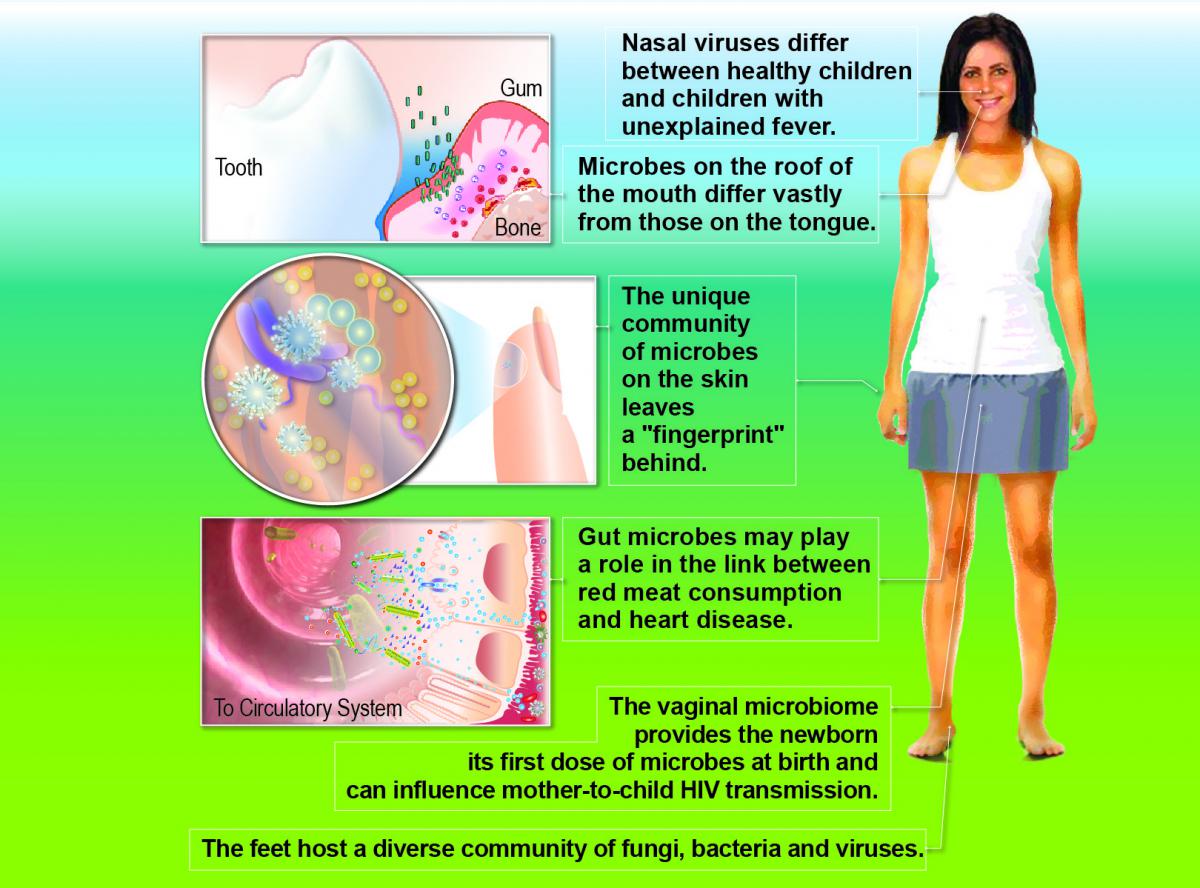Health Relevance
 Our bodies are inhabited by trillions of microorganisms. Yet, because of their small size (each microbe is less than 1% the width of a human hair), these rich communities of bacteria, fungi, and other microbes makes up only 1 to 2 percent of the body’s mass. Prior to the launch of the Common Fund’s Human Microbiome Project (HMP) in 2007, a growing body of evidence indicated these microbes that inhabit our bodies provide benefit. However, this was a hypothesis that was difficult to test. A census of all the microbes that live in and on our bodies – the microbiome – was not available, and there were few studies that linked changes in the human microbiome with changes in health. As this program has progressed, the world’s understanding of this human/microbiome ecosystem has been transformed. Research supported by HMP mapped the normal bacteria that live in and on the healthy human body. Importantly, HMP research revealed that though microbial community makeup can vary from person-to-person, the metabolic capabilities of these communities may correlate with health and disease. With a better understanding of what a “normal” human microbiome looks like, researchers are now exploring how changes in the microbiome are associated with, or even cause, illnesses. In addition, researchers supported across the NIH’s Institutes and Centers and around the globe are now developing new therapeutic approaches designed to manipulate the microbiome to treat disease as well as to restore and support health.
Our bodies are inhabited by trillions of microorganisms. Yet, because of their small size (each microbe is less than 1% the width of a human hair), these rich communities of bacteria, fungi, and other microbes makes up only 1 to 2 percent of the body’s mass. Prior to the launch of the Common Fund’s Human Microbiome Project (HMP) in 2007, a growing body of evidence indicated these microbes that inhabit our bodies provide benefit. However, this was a hypothesis that was difficult to test. A census of all the microbes that live in and on our bodies – the microbiome – was not available, and there were few studies that linked changes in the human microbiome with changes in health. As this program has progressed, the world’s understanding of this human/microbiome ecosystem has been transformed. Research supported by HMP mapped the normal bacteria that live in and on the healthy human body. Importantly, HMP research revealed that though microbial community makeup can vary from person-to-person, the metabolic capabilities of these communities may correlate with health and disease. With a better understanding of what a “normal” human microbiome looks like, researchers are now exploring how changes in the microbiome are associated with, or even cause, illnesses. In addition, researchers supported across the NIH’s Institutes and Centers and around the globe are now developing new therapeutic approaches designed to manipulate the microbiome to treat disease as well as to restore and support health.
Over the course of defining the human microbiome, HMP researchers also made numerous important scientific discoveries. Examples of these findings include:
- Our diets, and in particular fat and fiber intake, can have immediate and dramatic impacts on the makeup of our microbiome.
- The gut microbiome can metabolize a compound in red meat resulting in the formation of a different compound, TMAO, which has a known role in promoting cardiovascular disease.
- Alterations in the gut microbiome can have a direct effect on colon cancer development.
- The gut microbiome also has its own circadian rhythm, and a metabolite produced by these bacteria influences our own circadian rhythms. Furthermore, a high fat diet can alter the microbiome circadian rhythm, suggesting a link between our diet, the gut microbiome, and our circadian clocks.
- Monitoring the gut microbiome can be used as an early detection of Crohn’s disease and can also be used to monitor the effectiveness of various treatments.
For more information about interesting discoveries made by the HMP, visit HMP highlights page.



